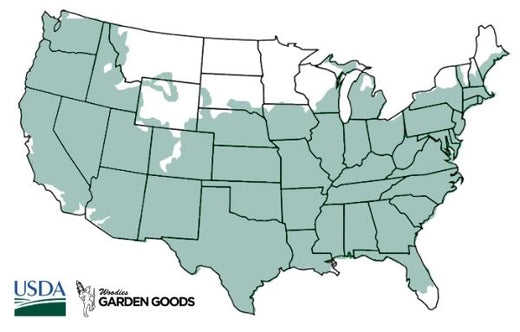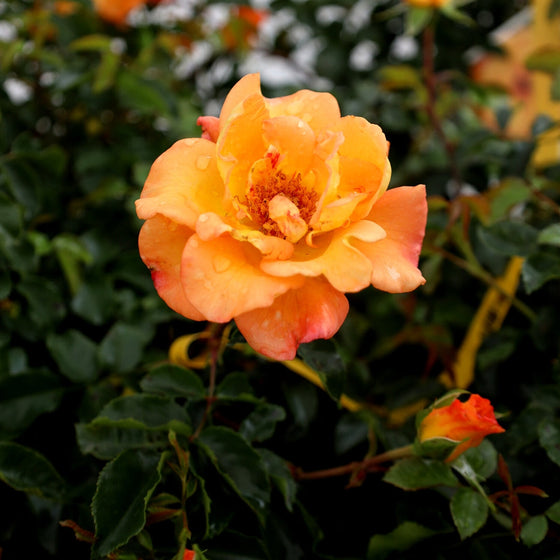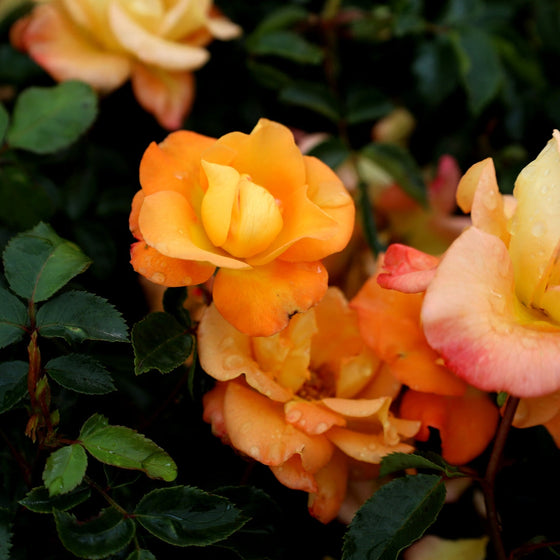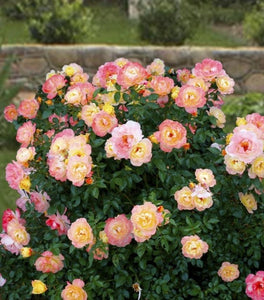
Images Depict Mature Plants
Sunorita® Rose for Sale Online
The Sunorita Rose is an elegant shrub rose that produces buds that are red-orange and open to reveal a soft orange flower that is composed of several dozen petals. As the flowers age, they develop a golden tone. The deep green leaves that cover this sturdy, medium-sized plant easily resists common rose diseases like black spot and powdery mildew.
Sunorita Rose blooms from spring through frost without deadheading. so sit back, relax and enjoy the roses.

| Hardiness Zone: | 5-9 |
|---|---|
| Mature Height: | 3 to 4 Feet |
| Mature width: | 3 to 4 Feet |
| Classification: | Broad leaved deciduous shrub rose |
| Sunlight: | Full sun for best blooms |
| Habit: | Upright |
| Foliage: | Dark green |
| Flower Color: | Orange |
| Pruning Season: | Prune in late winter |
| Soil Condition: | Any well drained soil |
| Water Requirements: | Water well until established |
| Uses: | Extremely attractive when used as in the mixed border, mass planting, or on a hillside |
How to Care for Sunorita® Rose
Be sure to read our planting instructions to ensure a healthy and happy plant for years to come!
How do I plant an Apricot Drift Rose Bush?
We suggest when planting your newly purchased Apricot Drift Rose Bushes that you dig a hole twice as wide as the root system but not deeper. The most common cause of plant death after transplanting is planting the new plant to deep. Depending on the quality of your existing soil you may need to add a locally sourced compost or topsoil to the back-fill soil. We do not recommend using straight topsoil or compost as a back-fill soil because more times than not these products will retain entirely to much moisture and will cause the root system to rot. Adding compost or topsoil will help the young feeder roots of Apricot Drift Rose Bushes to spread through the loose, nutrient rich soil, much easier than if you used solely the existing soil which more times than not will be hard and compacted.
How do I water Apricot Drift Rose Bushes?
After back filling and lightly compacting the 50/50 mix of existing soil and compost give Apricot Drift Rose Bushes a good deep watering. This is not to be rushed. Most of the water you put on the plant at first will run away from the plant until the soil is soaked. A general rule of thumb is to count to 5 for every one gallon of pot size. For example a one gallon pot would be watered until you count to 5 a three gallon pot would be 15 and so on. Check the plant daily for the first week or so and then every other day there after. Water using the counting method for the first few weeks. You’ll want to water the bushes regularly after planting until they’ve been well established. We like to tell folks that when watering Roses its best not to water the foliage of the plant. Water at the base of the plant near the soil line only. Although Drift Roses like Apricot Drift Rose are generally resistant to Black spot there are other foliage diseases that can effect roses in general that are favored by wet foliage conditions. Soaker Hoses can also be used to water when planting a long hedge.
How do I fertilize Apricot Drift Rose Bushes?
Groundcover roses such as Apricot Drift Rose Bushes grow best if they are fertilized once or twice in the summer. You should fertilize your roses monthly from springtime to fall. Apricot Drift Rose Bushes favor nutrient rich soil and ample fertilization. Try using some Epson salt as well. This will help boost the levels of magnesium in the soil which promotes increased flower production When selecting a fertilizer for your Apricot Drift Rose, use a rose fertilizer blended specifically for roses such as Espoma Rose Tone for example. Either chemical fertilizers or organic matter can be used successfully. Since an organic method of applying manure and/or compost around the roots, produces excellent results and also improves the condition of the soil, this would be an excellent first line of attack. A fast release fertilizer such as a 10-10-10 will work just as well if applied twice during the summer. If you are looking for a fertilizing routine tailored to your specific conditions, a soil sample should be taken and the fertilizer and trace elements matched to the needs of your soil. Don’t fertilize Apricot Drift Rose after August. Fall is the time for roses to begin preparing for dormancy. Fertilizing at this time may stimulate new growth that will be too tender to withstand the winter.
How do I mulch Apricot Drift Rose Bushes?
We highly recommend that you mulch your Apricot Drift Rose Bushes with either a ground hardwood mulch or a ground cypress mulch depending on your local availability. Any type of mulch will do but cypress or hardwood mulch will be of a higher quality and provide better nutrition overall as they breakdown. Mulching helps to keep weeds away which will compete with your new investment for water and nutrients. A 2 to 3 inch layer of mulch is sufficient but remember to take care not to cover any part of the stem of the plant with mulch. Its better to leave a one inch gap of space between the mulch and the stem or trunk of the plant.

















